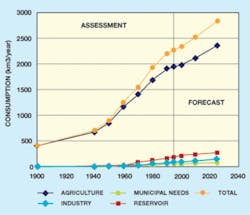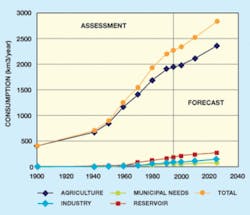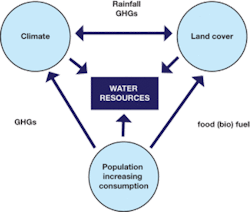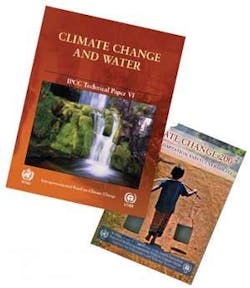By Alan Jenkins and Robert C. Ferrier
Competing policy demands mean greater complexity in how water supplies are managed, according to authors representing the UK’s Chartered Institution of Water & Environmental Management (CIWEM).
Nobody would argue with the need for integrated water resources management. Water is required for human consumption, industry, agriculture and to sustain essential ecosystem services. Demand is increasing at an alarming rate with agriculture ever thirstier (see Figure 1) In many basins, water resources are already in short supply relative to this demand and integrated management of land and water resources is required to try to ensure all sectors are satisfied equitably.
At a global scale, however, a crisis is looming with respect to managing land and water resources based around conflicts between water availability, energy demand and food production (see Figure 2). How do we provide more water and land for food to sustain the rapidly growing population, which hit six billion in 1999 and already is estimated at 6.7 billion today? Meanwhile, how do we meet the growing desire to satisfy an increasing energy gap with greener fuels that don’t harm the environment via emissions of carbon, nitrogen, particulates, etc? Biofuels are high on the energy policy ambition of countries worldwide but also require land and water. On top of all this, how do we ensure the natural environment is preserved and protected for future generations as well as to supply essential ecosystem services? For example, in many regions threatened natural wetlands and flood plains provide flow attenuation and purification properties in addition to supporting biodiversity. Such ecosystem services also can reduce future vulnerability to pressures such as climate change and protect human health and wellbeing.
All aspects of this nexus provide for a competition for available water resources at the catchment scale. Currently legislation is directed at all three areas: energy policy, food policy (e.g., in Europe through the Common Agricultural Policy) and water policy (e.g., in Europe through the Water Framework Directive). In addition, the threat of global climate change will potentially affect availability of water across the globe. This is also the subject of policy initiatives, such as the Kyoto protocol, which drive the need for less carbon emission and, hence, greener fuels. Unfortunately, these policies often conflict when managing water resources.
The UK’s Chartered Institution of Water and Environmental Management (CIWEM) has issued a position statement on water resources management plans that all water supply companies in the UK are required to specify. It notes that: “Water resources are the essence of life and have been a critical factor in the development of societies, communities and industries throughout time. Effective planning and management of water resources is essential now and in the future if sustainable development is to be ensured”. It further stresses good water resources management plans should encompass, among other things:
- Strategies that ensure sustainable water abstraction and water use now and in the future.
- Prevention of abstraction that has a damaging effect on the environment.
- Recognition of and adaptation to climate change impacts on water supply and demand.
- Mitigation of future climate change and its effects by reducing the emission of greenhouse gases resulting from water supply and treatment and use of water by consumers.
This clearly recognises the need to take account of conflicting policy demands at the level of individual river basins.
In addition, water resource management plans also have to consider the contribution of water supply activity in the future to greenhouse gas emissions. Are measures being proposed to optimise water resources management in a carbon neutral way? Water provided from desalinisation has a significantly higher carbon emission footprint than water supplied from groundwater aquifers. Although the raw material for desalinization, i.e., seawater, is effectively infinite, energy costs will become an increasing factor in limiting uptake of such technology in the world’s poorer and developing regions. On the other hand, groundwater aquifers aren’t of infinite volume and may not possess the capacity required for potential increased demand for agriculture. This, therefore, increases pressure on surface water abstraction where such resources exist.
The impact of climate and energy policy at national and international levels leads the drive toward increased biofuel production. Growing crops for bioethanol or biodiesel production will certainly require that more land is brought into production since there’s no possibility of reducing the currently cropped land for food production. In fact, there’s clearly competition for land with regard to energy crop and food production given the growing population of the world. New land brought into production is likely in many areas to be marginal, possibly requiring supplements of fertiliser to realise its full growth potential. The newly cropped areas also require water. If this is available as rainfall, so much the better, although “evapotranspiration” losses of increased crop cover may reduce water availability downstream for other uses and maintaining essential ecosystem services. If rainfall is low and irrigation necessary then water stress within the basin is likely to increase. And, in addition to the water requirement of the crop itself, significant water supply is required within the bio–refining process. There also exist implications regarding water quality downstream, for example, fertilizer runoff leading to nutrient pollution and soil erosion leading to sedimentation issues. Degraded water quality can render it unavailable for certain uses and so must be considered as a pressure or demand within the broader integrated water resources management at the basin level.
How can water and land managers cope with this complexity of issues and legislative requirements on the ground? That is, how do managers “operationalise” procedures for integrated water resources management in light of the complexity of issues and future uncertainty with regard climate change? It’s always possible, of course, to turn to science for the answers. Can increased water use efficiency be designed and built into all water use sectors, i.e., water supply, agricultural production (including irrigation and crop selection), industry, etc. Can basin scale water resources models be constructed at an appropriate scale to allow assessment of combinations of scenarios describing population change, biofuel requirement, ecosystem services, water supply and climate change? The answer is in the affirmative, but it will take time and scientific innovation, particularly with regard to better observed data (high spatial and temporal resolution), improved process understanding of the hydrological system, and improved future climate projections. It also requires an interdisciplinary approach linking natural sciences, engineering, social science and economics. This is a big task.
At a global scale, the magnitude of the water availability problem is clear. How do we grow sufficient crop to feed a rapidly expanding population and provide the increasing requirement for biofuels? Is the increased land area required located in a region with surplus water resources? It’s predicted that future climate change will change the distribution and quantity of runoff across the globe although there exists significant uncertainty around the model simulations (see Figure 3). With future climate change it may be necessary to grow crops in countries where they haven’t been produced previously. The global marketplace for energy, food and water may well change. The concept of future water wars has been considered by some as an impending consequence, though the fundamental human right of access to water has built bridges in some of the most troubled areas of the world. Water can and does unite people. At the operational level, each basin will have a different set of problems depending on the physical and cultural characteristics. Combinations of policies and the resultant actions need to link international processes and national perspectives to local actions. The future challenge facing water managers will need to manage the global issues at the basin scale. They very quickly need to be provided with the necessary tools to achieve this in an increasingly “integrated” way. Knowledge, capacity, supportive institutions, governance structures and political process will all be needed to build resilience in our rapidly changing world, in which water will be key.
Authors’ Notes:
Prof. Alan Jenkins is water programme leader and science director at the Centre for Ecology & Hydrology within the Natural Environment Research Council in Wallingford, UK. Dr. Robert C. Ferrier is Catchment Management Research Programme leader at the Macaulay Land Use Research Institute, Aberdeen, UK. Both are members of the UK’s Chartered Institution of Water & Environmental Management. Contact: +44 (0) 20 7831 3110 or www.ciwem.org







